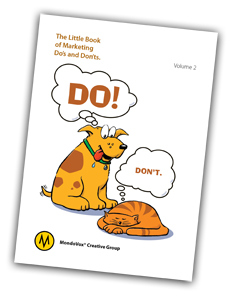 Postcards are more popular than ever, though many writers and designers run for cover when they hear the word. Some don’t like condensing the message into such a small space. Others dismiss them as low-end, low-value promotions for companies that can’t afford anything else.
Postcards are more popular than ever, though many writers and designers run for cover when they hear the word. Some don’t like condensing the message into such a small space. Others dismiss them as low-end, low-value promotions for companies that can’t afford anything else.
But savvy marketers know better.
Postcards can be performance powerhouses when done right. In fact, they sometimes do remarkably well even when done poorly. One of the reasons they continue to work is that postcards come “pre-opened.” There’s no decision to make. The offer is right in front of you. Postcards draw immediate attention and give you more than a fighting chance to entice the prospect even when you’re unknown.
Perfect for today’s over-messaged marketplace.
Understanding Postcard Basics.
Although our intent is to take the form to its highest level, there are four postcard basics that you need to get right no matter what technology you integrate into your campaigns:
- Attention-demanding Headline. You only get a few seconds to gain attention, so make your headline big and benefit oriented.
- Involving Visual. Draw in the recipient by making the visual and headline work as a team. Visuals should be as large and involving as possible. Showing a product or service in action is always effective.
- Persuasive Copy. Maintain interest with strong, feature- and benefit-oriented copy. Since you are likely using a multi-step approach, write your copy to entice and qualify.
- Call to Action. Be sure to tell the recipient exactly what action to take and don’t assume anything. Direct the person to “Call toll free today for a free sample and information kit,” or whatever is the appropriate action for your program. Multiple, user-friendly options tend to work best.
Adding Some Technology Juice.
Separate your postcards from the competition by taking advantage of today’s technology.
- Do Your Database Work. From variable data digital printing to inkjet imaging, print technology provides a lot of opportunities to personalize and customize your postcard mailings. There’s a strong likelihood that you have plenty of existing data to elevate the performance of your postcards. Start simply if you must and work your way up, but do use your data. Every personalization step you take will deliver better results. Keep in mind that there’s also worthwhile demographic information you can append from outside sources while you’re building your internal database. Seek help if you need it.
- Personalize. Get past the “name thing” quickly. It’s not that using someone’s name isn’t worthwhile—it is—but today’s variable technologies allow you to do so much more with photos, graphics and copy if you know anything at all about your target. You can create postcards that are variable in every respect with digital presses or do something as simple as offline- inkjet imaging a store location map when you’re doing the addressing. You can also create postcards with personalized URLs (pURLs) that connect recipients to a personal landing page where they typically receive an incentive for their effort. Many times there are additional offers beyond the original promise, such as an opt-in newsletter or club membership, available at the personal landing page. Besides the personalization effect, the big benefit of pURLs is that they provide a reliable method for tracking postcard recipients who went online as a result of the promotion, whether or not they took advantage of the offer.
- Involve. Postcards can now be more involving than ever. QR Codes, which are hotter than hot, are two-dimensional barcodes that enable smartphone users equipped with the correct reader software to scan the code. This causes the phone’s browser to launch and redirect to the programmed URL. A real estate company, for example, could offer a property on the postcard and the QR code might take the recipient to a video tour of the home. But don’t dismiss other involvement devices such as scratch-offs, repositionable notes and other proven techniques.
The bottom line is that postcards not only work, but also are evolving tools that can achieve virtually any level of marketing sophistication your program requires.
By Larry Bauer
Want Expert Advice?
MondoVox Creative Group can help you develop postcard campaigns that take advantage of today’s technology. For more information, email Julia Moran Martz.
You can connect with Julia Moran Martz on LinkedIn. Or follow her on Twitter.
 Missed Getting Your Copy of The Little Book of Marketing Do’s & Don’ts? Not to worry. We’ve made digital versions of all three volumes available via SlideShare. The Little Book of Marketing Do’s & Don’ts is a collection of the most viewed “Do’s & Don’ts” published by our MondoBeat newsletter including:
Missed Getting Your Copy of The Little Book of Marketing Do’s & Don’ts? Not to worry. We’ve made digital versions of all three volumes available via SlideShare. The Little Book of Marketing Do’s & Don’ts is a collection of the most viewed “Do’s & Don’ts” published by our MondoBeat newsletter including: Give a donation with a twist. Donations in honor of your customers aren’t novel, but getting them involved in the act is a fun twist. Select four or five charities and establish a pool of money (you don’t need to reveal the size of the pool). Send a letter explaining the program and ask them to designate the charity of their choice from the list. Customers can respond through a postage-paid postcard, an email or a personalized URL that takes them to their own landing page. You simply divide the money by the percentage of votes and have the charity send a recognition letter to each participant without stating the amount of the gift. Low cost. Multiple touches. Customer involvement.
Give a donation with a twist. Donations in honor of your customers aren’t novel, but getting them involved in the act is a fun twist. Select four or five charities and establish a pool of money (you don’t need to reveal the size of the pool). Send a letter explaining the program and ask them to designate the charity of their choice from the list. Customers can respond through a postage-paid postcard, an email or a personalized URL that takes them to their own landing page. You simply divide the money by the percentage of votes and have the charity send a recognition letter to each participant without stating the amount of the gift. Low cost. Multiple touches. Customer involvement.






